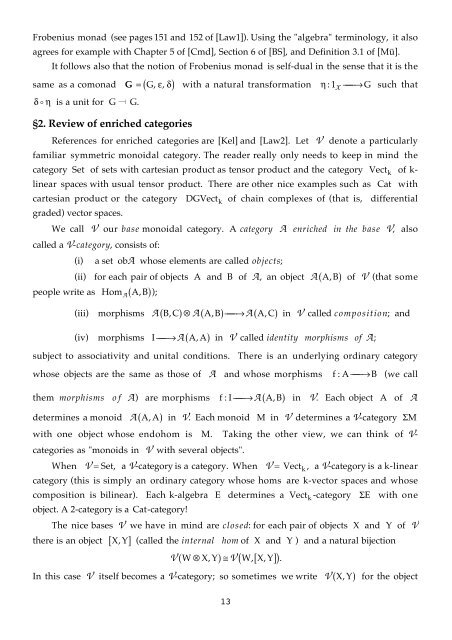Frobenius monads and pseudomonoids Introduction - ResearchGate
Frobenius monads and pseudomonoids Introduction - ResearchGate
Frobenius monads and pseudomonoids Introduction - ResearchGate
Create successful ePaper yourself
Turn your PDF publications into a flip-book with our unique Google optimized e-Paper software.
<strong>Frobenius</strong> monad (see pages 151 <strong>and</strong> 152 of [Law1]). Using the "algebra" terminology, it also<br />
agrees for example with Chapter 5 of [Cmd], Section 6 of [BS], <strong>and</strong> Definition 3.1 of [Mü].<br />
It follows also that the notion of <strong>Frobenius</strong> monad is self-dual in the sense that it is the<br />
same as a comonad<br />
d h o is a unit for G J G.<br />
G = ( G, , )<br />
§2. Review of enriched categories<br />
e d with a natural transformation h :1X æÆ æ G such that<br />
References for enriched categories are [Kel] <strong>and</strong> [Law2]. Let V denote a particularly<br />
familiar symmetric monoidal category. The reader really only needs to keep in mind the<br />
category Set of sets with cartesian product as tensor product <strong>and</strong> the category Vectk of klinear<br />
spaces with usual tensor product. There are other nice examples such as Cat with<br />
cartesian product or the category DGVectk of chain complexes of (that is, differential<br />
graded) vector spaces.<br />
We call V our base monoidal category. A category A enriched in the base V, also<br />
called a V-category, consists of:<br />
(i) a set obA whose elements are called objects;<br />
(ii) for each pair of objects A <strong>and</strong> B of A, an object A ( AB , ) of V (that some<br />
people write as Hom ( A, B));<br />
A<br />
(iii) morphisms A ( BC , ) ƒ A ( AB , ) æÆ æ A ( AC , ) in V called composition; <strong>and</strong><br />
(iv) morphisms<br />
I æÆA<br />
A, A in V called identity morphisms of A;<br />
æ ( )<br />
subject to associativity <strong>and</strong> unital conditions. There is an underlying ordinary category<br />
whose objects are the same as those of A <strong>and</strong> whose morphisms f: A æÆ æ B (we call<br />
them morphisms o f A) are morphisms<br />
f: I æÆA<br />
A, B in V. Each object A of A<br />
æ ( )<br />
determines a monoid A ( AA , ) in V. Each monoid M in V determines a V-category SM<br />
with one object whose endohom is M. Taking the other view, we can think of V-<br />
categories as "monoids in V with several objects".<br />
When V = Set, a V-category is a category. When V = Vectk , a V-category is a k-linear<br />
category (this is simply an ordinary category whose homs are k-vector spaces <strong>and</strong> whose<br />
composition is bilinear). Each k-algebra E determines a Vectk -category SE with one<br />
object. A 2-category is a Cat-category!<br />
The nice bases V we have in mind are closed: for each pair of objects X <strong>and</strong> Y of V<br />
there is an object [ XY , ] (called the internal hom of X <strong>and</strong> Y ) <strong>and</strong> a natural bijection<br />
( )<br />
V W X Y V W X Y<br />
ƒ ( ) @ , , [ , ] .<br />
In this case V itself becomes a V-category; so sometimes we write V ( XY , ) for the object<br />
13
















